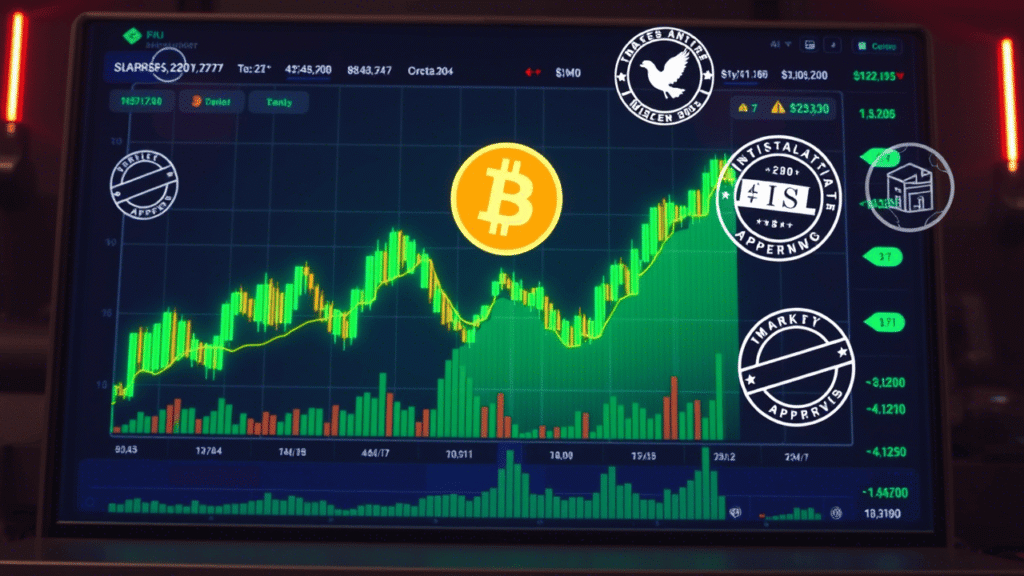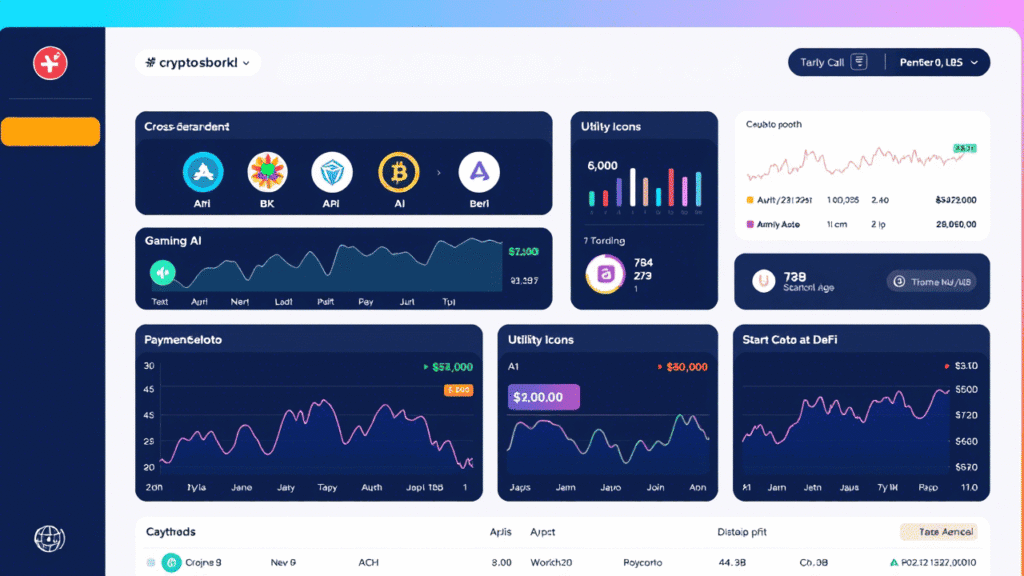The crypto currency market is experiencing a remarkable resurgence in 2025, with digital assets demonstrating renewed strength after weathering significant volatility in previous years. As institutional adoption accelerates and regulatory frameworks become clearer, savvy investors are positioning themselves to capitalize on what many experts consider the next major crypto bull run. This comprehensive analysis explores the most promising cryptocurrency investments for 2025, backed by market data, technical analysis, and fundamental developments that are driving this remarkable comeback.
The current market landscape presents unique opportunities for both seasoned cryptocurrency veterans and newcomers looking to enter the digital asset space. With Bitcoin’s dominance strengthening and altcoins showing distinct signs of recovery, understanding which coins offer the best risk-adjusted returns becomes crucial for portfolio success.
Market Recovery Analysis and Current Trends
The cryptocurrency market has shown remarkable resilience in 2025, with total market capitalization recovering from previous lows and institutional interest reaching unprecedented levels. Bitcoin is projected to trade between $80,440 and $151,200 in 2025, with stretched targets reaching $175,000 to $185,000, indicating strong bullish momentum driven by ongoing institutional adoption and broader acceptance.
Bitcoin continued to climb in dominance, increasing by 4.6 percentage points in 2025 Q1, ending the quarter with a 59.1% dominance, demonstrating its role as the digital gold standard during market uncertainty. This dominance increase suggests that while the overall market faces challenges, Bitcoin remains the preferred choice for institutional and retail investors seeking exposure to cryptocurrency.
The market recovery is being fueled by several key factors: improved regulatory clarity in major jurisdictions, the approval and success of Bitcoin ETFs, and growing corporate treasury adoption. Major financial institutions are no longer viewing cryptocurrency as a speculative asset class but rather as a legitimate store of value and hedge against traditional market volatility.
The global cryptocurrency market size is expected to reach $5.43 billion by 2029 at a 17.3% growth rate, highlighting the long-term growth trajectory that extends well beyond the current market cycle. This projected growth encompasses various segments including Bitcoin, Ethereum, and emerging altcoins that are driving innovation across multiple sectors.
Furthermore, technological advancements in blockchain infrastructure, improved scalability solutions, and the growing adoption of decentralized finance (DeFi) protocols are creating a more robust foundation for sustained growth. The integration of artificial intelligence with blockchain technology and the emergence of real-world asset tokenization are opening new avenues for cryptocurrency utility and value creation.
“The cryptocurrency market in 2025 represents a maturation phase where institutional adoption meets technological innovation, creating unprecedented opportunities for strategic investors who understand the fundamentals driving long-term value creation.”

Bitcoin: The Foundation of Crypto Recovery
Bitcoin continues to lead the cryptocurrency market recovery, serving as both a store of value and a gateway asset for institutional investors entering the digital currency space. The world’s first cryptocurrency has demonstrated remarkable resilience, maintaining its position as the most trusted and widely adopted digital asset despite market fluctuations.
Industry experts project Bitcoin prices could reach as high as $150,000 in 2025, with Galaxy Digital’s head of research targeting $185,000, reflecting the optimistic outlook among professional analysts and institutional investors. These price projections are based on multiple convergent factors including supply scarcity, increasing demand, and macroeconomic conditions favoring hard assets.
The Bitcoin network’s fundamentals remain exceptionally strong, with hash rate reaching all-time highs and network security continuously improving. The recent halving event has reduced new Bitcoin supply by 50%, creating a supply shock that historically leads to significant price appreciation over the following 12-18 months. Combined with growing demand from ETFs and corporate treasuries, this supply-demand imbalance creates compelling upward pressure on Bitcoin’s price.
Institutional adoption continues to accelerate, with major corporations adding Bitcoin to their balance sheets and pension funds beginning to allocate portions of their portfolios to the digital asset. The approval and success of Bitcoin ETFs have removed significant barriers to institutional participation, allowing traditional investment managers to gain Bitcoin exposure without directly holding the underlying asset.
The macroeconomic environment also favors Bitcoin’s continued appreciation. With central banks maintaining expansionary monetary policies and concerns about currency debasement persisting, Bitcoin’s fixed supply cap of 21 million coins makes it an attractive hedge against inflation and monetary instability. Professional investors increasingly view Bitcoin as “digital gold,” a designation that supports higher valuations as the asset class matures.
Bitcoin’s technological development continues with improvements to the Lightning Network enabling faster, cheaper transactions, and the emergence of Bitcoin-based DeFi protocols expanding its utility beyond simple value storage. These developments strengthen Bitcoin’s fundamental value proposition while opening new use cases that could drive additional demand.
“Bitcoin’s evolution from speculative asset to institutional-grade store of value represents one of the most significant financial innovations of the 21st century, with 2025 marking a pivotal year for mainstream adoption and price discovery.”

Ethereum and Smart Contract Platforms
Ethereum remains the undisputed leader in smart contract functionality and decentralized application development, positioning it as a cornerstone investment for the 2025 crypto recovery. The platform’s transition to Proof-of-Stake consensus has significantly improved its energy efficiency and scalability, addressing two major criticisms that previously limited institutional adoption.
The Ethereum ecosystem continues to evolve rapidly, with Layer 2 scaling solutions like Arbitrum, Optimism, and Polygon processing millions of transactions daily while maintaining security through Ethereum’s base layer. These developments have dramatically reduced transaction costs and improved user experience, making Ethereum-based applications accessible to mainstream users and enterprise clients.
Ether’s market cap of almost $329.5 billion positions it as the second-largest cryptocurrency, though this valuation may not fully reflect the platform’s true utility and growth potential. The Ethereum network processes more economic value than any other blockchain, with decentralized finance protocols, NFT marketplaces, and enterprise applications generating billions in transaction volume monthly.
The upcoming Ethereum upgrades, including sharding and further protocol improvements, promise to increase the network’s capacity significantly while maintaining decentralization and security. These technical improvements, combined with growing institutional interest in DeFi and tokenized assets, create a compelling investment thesis for Ethereum in 2025.
Beyond Ethereum, other smart contract platforms are gaining traction and market share. Solana has demonstrated remarkable resilience and continued growth, with its high-performance blockchain attracting developers building consumer-facing applications that require fast transaction processing and low fees. The Solana ecosystem encompasses everything from DeFi protocols to gaming applications and social media platforms.
Cardano represents another significant opportunity, with its methodical approach to blockchain development and strong focus on academic research yielding a robust platform for enterprise applications. The platform’s emphasis on sustainability and interoperability positions it well for institutional adoption, particularly in developing markets where energy efficiency and cost-effectiveness are paramount concerns.
Avalanche has emerged as a strong competitor in the smart contract space, offering sub-second finality and customizable blockchain solutions that appeal to enterprise clients. Its unique consensus mechanism and subnet architecture allow for specialized blockchains that can meet specific industry requirements while maintaining interoperability with the broader Avalanche ecosystem.
“Smart contract platforms are becoming the foundation of a new digital economy, with Ethereum leading the charge while innovative competitors push the boundaries of what’s possible with blockchain technology.”

Promising Altcoins and Emerging Opportunities
The altcoin market in 2025 presents numerous opportunities for investors seeking higher returns through strategic exposure to innovative blockchain projects. While Bitcoin and Ethereum dominate market capitalization, several emerging cryptocurrencies offer compelling value propositions based on unique technological innovations and growing adoption.
XRP remains a major player in cross-border transactions, gaining adoption among financial institutions and considered one of the best crypto investments for 2025. The resolution of Ripple’s legal challenges has cleared a path for institutional adoption, with banks and payment processors increasingly implementing XRP for international transfers due to its speed and cost advantages over traditional systems.
The potential approval of an XRP ETF could trigger significant institutional inflows similar to Bitcoin’s explosive rally following ETF approval. Financial institutions are recognizing XRP’s utility for treasury management and cross-border payments, creating sustainable demand beyond speculative trading. Major banks in Asia and Europe have already integrated RippleNet for commercial payments, validating the technology’s real-world utility.
Chainlink continues to dominate the oracle space, providing essential data connectivity between blockchain networks and real-world information sources. As smart contracts become more sophisticated and require reliable external data feeds, Chainlink’s network becomes increasingly valuable. The platform’s expansion into cross-chain interoperability and data verification services positions it well for continued growth.
Polygon has established itself as the leading Ethereum scaling solution, with major brands and applications choosing Polygon for their blockchain deployments. The platform’s focus on user experience and developer tools has attracted significant enterprise adoption, including partnerships with major social media platforms and gaming companies.
The artificial intelligence and blockchain convergence creates opportunities in tokens like SingularityNET, which focuses on decentralized AI services, and Ocean Protocol, which enables secure data sharing for AI applications. These projects represent the intersection of two major technological trends that could drive significant value creation.
Gaming and metaverse tokens offer exposure to the rapidly growing play-to-earn economy. Projects like Axie Infinity, The Sandbox, and Decentraland have demonstrated the potential for blockchain-based gaming, while newer entrants focus on improved gameplay and broader market appeal. The gaming industry’s shift toward blockchain integration creates long-term growth opportunities.
Infrastructure tokens serving the broader cryptocurrency ecosystem also present compelling opportunities. Projects providing decentralized storage, computing power, and network services benefit from the overall growth of the crypto economy while offering utility-based value propositions that extend beyond pure speculation.
“The altcoin market in 2025 rewards projects that solve real problems and demonstrate genuine utility, moving beyond speculative trading toward sustainable value creation based on technological innovation and market adoption.”

Investment Strategies and Risk Management
Successful cryptocurrency investing in 2025 requires sophisticated strategies that balance growth potential with prudent risk management. The maturation of the crypto market demands more nuanced approaches than the simple “buy and hold” strategies that worked during earlier bull markets.
Dollar-cost averaging remains one of the most effective strategies for building cryptocurrency positions, particularly during volatile market conditions. By investing fixed amounts at regular intervals, investors can reduce the impact of short-term price fluctuations while building substantial positions over time. This approach works especially well for Bitcoin and Ethereum, where long-term trends favor appreciation despite short-term volatility.
Portfolio diversification across different cryptocurrency categories helps optimize risk-adjusted returns. A balanced crypto portfolio might include Bitcoin for store of value, Ethereum for smart contract exposure, several promising altcoins for growth potential, and stablecoins for liquidity and risk management. The specific allocation depends on individual risk tolerance and investment timeline.
Technical analysis becomes increasingly important as cryptocurrency markets mature and develop more traditional trading patterns. Understanding support and resistance levels, trend indicators, and market sentiment can help investors time entries and exits more effectively. However, fundamental analysis remains crucial for identifying projects with long-term viability and growth potential.
Risk management strategies must account for cryptocurrency’s inherent volatility and regulatory uncertainty. Position sizing becomes critical – no single cryptocurrency should represent more than 5-10% of an overall investment portfolio for most investors. Stop-loss orders and profit-taking strategies help protect gains while limiting downside exposure.
The emergence of cryptocurrency derivatives and structured products provides additional tools for sophisticated investors. Options strategies can provide downside protection while maintaining upside exposure, while futures contracts enable hedging strategies that reduce portfolio volatility.
Regulatory developments require constant monitoring, as government actions can significantly impact cryptocurrency prices and market access. Staying informed about regulatory trends in major jurisdictions helps investors anticipate potential market movements and adjust strategies accordingly.
Tax considerations play an increasingly important role in cryptocurrency investing. Understanding the tax implications of trading, staking rewards, and DeFi activities helps optimize after-tax returns while ensuring compliance with evolving regulations.
Security remains paramount in cryptocurrency investing. Using hardware wallets for long-term storage, implementing strong authentication measures, and staying informed about common security threats protects investors from theft and fraud that could eliminate investment gains entirely.
“Successful cryptocurrency investing in 2025 combines technological understanding with disciplined risk management, moving beyond speculation toward strategic allocation based on fundamental value and market dynamics.”

Regulatory Landscape and Market Implications
The regulatory environment surrounding cryptocurrencies has evolved significantly in 2025, creating a more stable foundation for institutional adoption while maintaining innovation-friendly policies that support continued growth. Major jurisdictions have implemented comprehensive frameworks that provide clarity for businesses and investors while addressing concerns about consumer protection and financial stability.
The United States has emerged with clearer regulatory guidelines, with federal agencies providing definitive classifications for various cryptocurrency categories. The approval of Bitcoin and Ethereum ETFs represents a watershed moment for institutional acceptance, while stablecoin regulations provide a framework for digital dollar adoption in commercial applications.
European Union’s Markets in Crypto-Assets (MiCA) regulation has created a unified regulatory framework across member states, providing legal certainty for cryptocurrency businesses while establishing consumer protection standards. This regulatory clarity has encouraged European financial institutions to offer cryptocurrency services and has attracted blockchain companies to establish operations within the EU.
Asian markets continue to play a crucial role in cryptocurrency adoption, with countries like Singapore and Hong Kong implementing progressive regulatory frameworks that balance innovation with risk management. Japan’s mature regulatory approach continues to serve as a model for other developed nations, while emerging markets explore central bank digital currencies (CBDCs) that could drive broader cryptocurrency adoption.
The regulatory developments have several important implications for cryptocurrency investors. Institutional products like ETFs and professionally managed funds provide regulated exposure to cryptocurrency markets, reducing counterparty risk while enabling traditional investment approaches. Banking integration allows seamless fiat-to-crypto conversions and custody services that meet institutional standards.
Tax clarity in major jurisdictions has removed significant uncertainty that previously limited institutional adoption. Clear guidance on capital gains treatment, staking rewards, and DeFi activities allows for proper tax planning and compliance, making cryptocurrency investments more accessible to tax-sensitive institutional investors.
Compliance requirements for cryptocurrency exchanges and service providers have increased barriers to entry while improving consumer protection and market integrity. Licensed exchanges must maintain proper reserves, implement anti-money laundering procedures, and provide transparent reporting, creating a more trustworthy ecosystem for mainstream adoption.
The emergence of central bank digital currencies (CBDCs) creates both opportunities and challenges for private cryptocurrencies. While CBDCs may compete with stablecoins for certain use cases, they also validate the underlying blockchain technology and could drive broader digital currency adoption that benefits the entire ecosystem.
International coordination on cryptocurrency regulation continues to develop through organizations like the Financial Stability Board and the Bank for International Settlements. This coordination helps prevent regulatory arbitrage while ensuring that cryptocurrency innovations can develop within appropriate risk management frameworks.
“The maturing regulatory landscape in 2025 transforms cryptocurrency from a speculative frontier into a legitimate asset class with clear rules and institutional-grade infrastructure, paving the way for mainstream adoption and sustainable growth.”
Technology Innovations Driving Growth
The cryptocurrency ecosystem in 2025 benefits from significant technological innovations that address scalability, interoperability, and user experience challenges that previously limited mainstream adoption. These technological advances create new investment opportunities while strengthening the fundamental value proposition of blockchain networks.
Layer 2 scaling solutions have matured significantly, with optimistic rollups and zero-knowledge proofs enabling thousands of transactions per second while maintaining the security guarantees of underlying blockchain networks. These solutions dramatically reduce transaction costs and confirmation times, making blockchain applications viable for everyday use cases that require micropayments or high-frequency interactions.
Cross-chain interoperability protocols have evolved to enable seamless asset transfers and communication between different blockchain networks. Projects like Cosmos, Polkadot, and various bridge protocols create a more connected blockchain ecosystem where specialized networks can interact efficiently while maintaining their unique characteristics and optimization focus.
The integration of artificial intelligence with blockchain technology opens new possibilities for automated trading, risk assessment, and protocol optimization. AI-powered systems can analyze vast amounts of market data to identify patterns and opportunities that human traders might miss, while smart contracts can implement sophisticated decision-making logic that adapts to changing market conditions.
Privacy-preserving technologies continue to advance, with zero-knowledge proofs enabling private transactions while maintaining network security and regulatory compliance. These technologies address legitimate privacy concerns while preventing the use of cryptocurrencies for illicit activities, creating a balance that supports both innovation and regulatory acceptance.
The development of quantum-resistant cryptography ensures that blockchain networks remain secure as quantum computing capabilities advance. Projects implementing post-quantum cryptographic standards protect long-term value storage while maintaining confidence in the security of digital assets as computing technology evolves.
Sustainability improvements across blockchain networks address environmental concerns that previously limited institutional adoption. Proof-of-stake consensus mechanisms, renewable energy mining operations, and carbon offset programs demonstrate the industry’s commitment to environmental responsibility while maintaining network security and decentralization.
User experience innovations focus on making cryptocurrency applications as easy to use as traditional financial services. Improved wallet interfaces, seamless onboarding processes, and integration with existing financial infrastructure reduce barriers to adoption while maintaining the security and sovereignty benefits of blockchain technology.
The emergence of programmable money through smart contracts enables new financial products and services that were impossible with traditional monetary systems. Automated market makers, yield farming protocols, and synthetic assets create new investment opportunities while demonstrating the flexibility and innovation potential of blockchain-based financial systems.
“Technological innovation in 2025 transforms blockchain from a promising experiment into practical infrastructure that rivals and enhances traditional financial systems, creating sustainable value that extends far beyond speculative trading.”

The cryptocurrency market comeback of 2025 represents a fundamental shift from speculative mania to sustainable growth based on real utility and institutional adoption. With Bitcoin projected to reach new heights, Ethereum continuing to dominate smart contract functionality, and promising altcoins offering diversified exposure to blockchain innovation, strategic investors have unprecedented opportunities to participate in this digital financial revolution.
The key to success lies in understanding that cryptocurrency investing has matured beyond simple speculation into sophisticated portfolio allocation requiring technical knowledge, fundamental analysis, and prudent risk management. The regulatory clarity emerging across major jurisdictions, combined with technological innovations addressing scalability and user experience, creates a foundation for sustained growth that extends well beyond current market cycles.
Bitcoin’s role as digital gold continues to strengthen, offering portfolio diversification and inflation hedging that appeals to institutional investors managing large asset pools. Ethereum’s position as the foundation for decentralized finance and web3 applications provides exposure to the fastest-growing segments of the digital economy, while carefully selected altcoins offer opportunities for higher returns through exposure to emerging technologies and use cases.
The importance of proper risk management cannot be overstated in this rapidly evolving market. Dollar-cost averaging, portfolio diversification, security best practices, and tax-efficient strategies remain essential components of successful cryptocurrency investing. As the market matures, these traditional investment principles become increasingly relevant while maintaining appreciation for the unique characteristics of digital assets.
Looking forward, the convergence of artificial intelligence, blockchain technology, and traditional finance creates opportunities that extend far beyond current cryptocurrency valuations. The tokenization of real-world assets, the growth of decentralized autonomous organizations, and the development of programmable money represent just the beginning of blockchain’s transformation of global financial systems.
The 2025 crypto comeback rewards investors who combine technological understanding with disciplined investment strategies, positioning themselves to benefit from one of the most significant financial innovations of the modern era while managing the inherent risks of this dynamic and rapidly evolving market.





